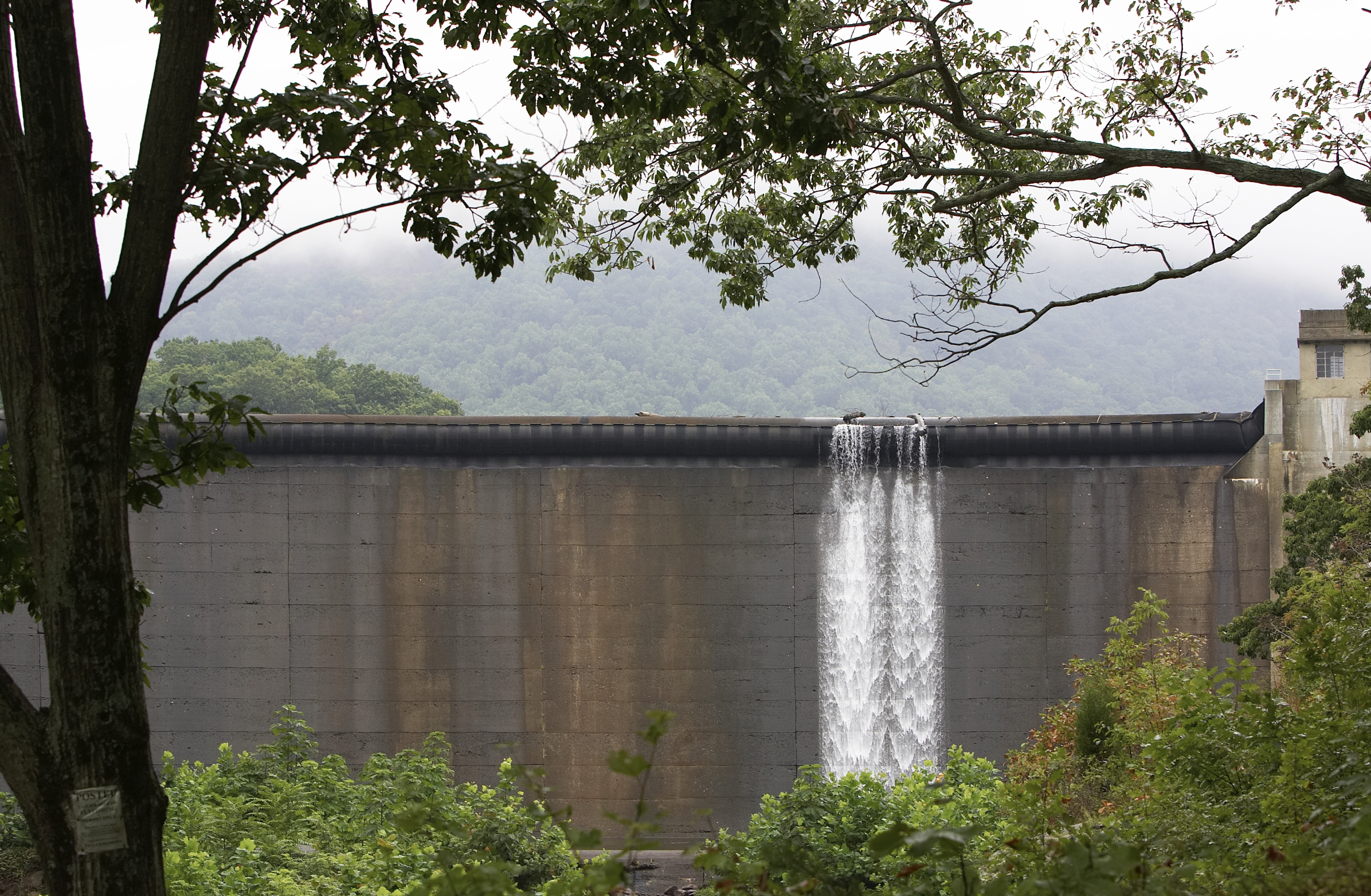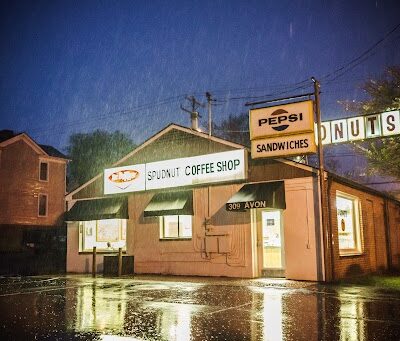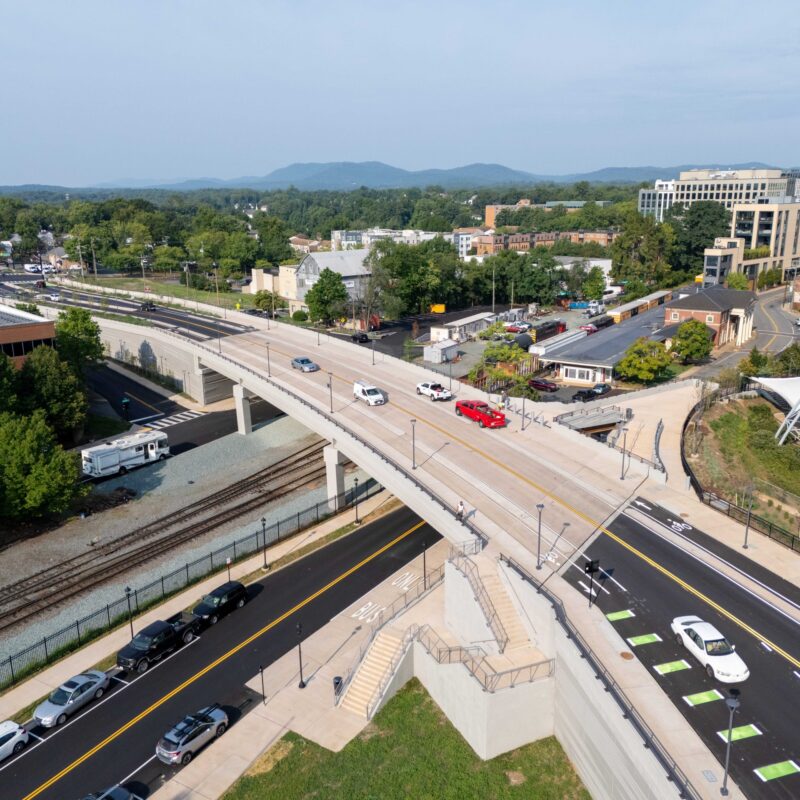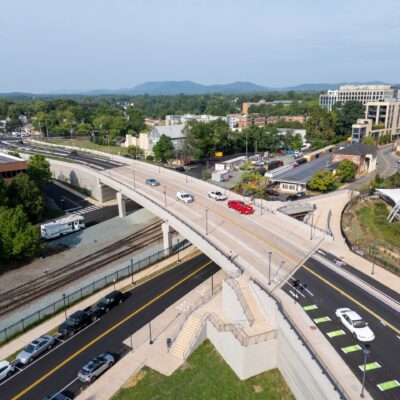The snow fell. The power failed. The plant flooded. The water stopped.
For more than 115 hours across six calendar days last January, the City of Richmond lost clean drinking water. For much of that time, its taps ran dry.
According to reporting from the Richmond Times-Dispatch, three inches of fallen snow and a resulting power outage led to a cascade of system failures at its sole water treatment plant early on January 6, 2025. Richmond couldn’t restore full pressure until early January 9. After time for required safety testing, the city declared its water once more safe to drink on January 11.
As the climate changes and storms intensify, as infrastructure ages, as the Charlottesville area’s population grows, could our own water supply face similar threats?
To answer that, you’ll need to understand where our water comes from, where it goes, and how it gets there.

The land
The water we drink begins as rain, falling straight into our waterways or filtered through the land. We call that land a watershed.
“A watershed is the whole system,” says Leon Szeptycki, a UVA law professor, water expert, and associate director of the university’s environmental institute. “It’s all the land that the water flows off of, and everything associated with the land.” The health of that area affects how well the land stores and filters water—and how it reacts to sudden severe weather.
Water that falls on roofs, streets, and parking lots can’t soak into the ground, Szeptycki notes. It’ll run into storm sewers and get dumped into rivers and streams, potentially worsening flooding. But rainfall on forests gets partially blocked by tree canopy, and absorbed by trees, other plants, and the ground, reducing the amount of surface water that can contribute to a damaging flood.
“The more intact your watershed is—and by intact, I mean the fewer impervious surfaces there are, the more trees there are, the more healthy landscapes there are—the more water the watershed is going to retain, and the less severe floods are going to be,” Szeptycki says.
Unfortunately for Charlottesville and Albemarle County, local forests appear to be shrinking. In the city, the percentage of land covered by trees has fallen from 45 percent in 2014 to 38 percent in 2023, according to the City of Charlottesville Tree Commission’s State of the Forest report from that year.
Numbers for the county are harder to pin down: A 2023 report from the Chesapeake Bay Program puts Albemarle’s tree coverage at 68.7 percent in 2017-18, with 1,427 acres of forest lost since 2013-14. The county’s website lists coverage at 72 percent forest, 24 percent open land, and 3 percent impervious surfaces, but doesn’t provide a date for those figures.
A changing climate could make water more precious and floods more frequent. “As the temperature gets warmer,” Szeptycki says, “it increases water demand by natural vegetation, people water their lawns more, farmers irrigate their crops more when it’s warmer, and depending on the particular river or stream, warmer temperatures can put more stress on aquatic ecosystems.”
Charlottesville’s 2023 climate risk and vulnerability assessment predicts that the city’s annual number of days with temperatures 95 degrees Fahrenheit or hotter could rise from 10 in 2020 to 25 in 2050—up from just three days per year in 1950. Heat waves, where those high temperatures exceed the historical average for five or more days, could rise from three to seven per year in the same period.
At the same time, the city’s expecting fiercer storms and floods. Its 2023 report forecasts one extra severe rain or snowstorm per year—rising from 12 to 13—in 2050, compared to 2020. “But in between those more intense storms, there’ll be longer, more intense dry periods,” Szeptycki says. “We have to make sure we have enough water during the longer drier periods. And the best way of dealing with that is storage.”

The water
In 2002, Charlottesville suffered its worst drought since 1930. The reservoirs, full that June, fell to 50 percent capacity. Charlottesville successfully endured mandatory water restrictions to curb demand and slow down the depletion. Before renewed rainfall refilled its supplies that October, the city had less than three months before it ran out of water entirely.
In response, the city, county, and local authorities launched a 10-year water supply planning process, and a decade-plus of subsequent work, to ensure that grim deadline would never recur.
“In the past 20 years, we’ve made significant planning and capital investments to improve our infrastructure and services to the community,” said Westley Kern, communications and outreach coordinator for the Rivanna Water & Sewer Authority. “Our goal, and ultimately our responsibility, is to continually adapt and improve our water systems so that we don’t strain our water supplies.” The agency, founded by the city and county in 1972, collects, stores, and treats the area’s water and wastewater.
Collectively, Rivanna’s reservoirs hold 3.3 billion gallons of water, and their plants can treat a maximum 24 million gallons per day. Even in the worst, deepest drought conditions planners have envisioned, Rivanna says its system can process 15 million gallons of water a day—half again the current daily demand—without endangering the overall supply.
Crozet and Scottsville have their own smaller reservoirs and treatment plants, and the city and surrounding areas’ supply is supplemented by a reservoir at Sugar Hollow. But most of the water flowing from your taps likely comes from one of Rivanna’s two main reservoirs: Ragged Mountain, east and south of the city near I-64, and South Fork Rivanna, ironically north of the city and just east of Seminole Trail.
South Fork is smaller, holding 885 million gallons when full, but it’s fed by a vast 259-square-mile watershed. Ragged Mountain, its big sibling, currently holds around 1.5 billion gallons, after 2014 renovations helped increase its capacity. Further improvements planned to begin this year will add another 700 million gallons—enough for 68 days’ more demand at current rates. But Ragged Mountain’s only fed by a comparatively meager two square miles of watershed.
Big reservoir, small watershed. Small reservoir, big watershed. See the problem? So did local officials. That’s why the $550 million in capital improvements Rivanna has planned over the next five years includes a seven-mile pipeline between South Fork and Ragged Mountain, so that water flowing into the former can be saved up in the latter for a not-so-rainy day. “It’s been designed to transfer up to 25 million gallons per day between those two reservoirs, depending upon need,” says Quin Lunsford, executive director of the Albemarle County Service Authority.
Unlike Richmond, Charlottesville and Albemarle’s drinkable water isn’t vulnerable to a single point of failure. The area’s multiple treatment plants have received major upgrades over the past decade, expanding their capacity and replacing older components. Each plant has a backup generator that Rivanna tests monthly at the same levels that an emergency would require.
The South Rivanna treatment plant, behind the DoubleTree Hotel, currently shoulders the bulk of the system’s needs. In RWSA’s daily report for June 24, it processed more than 9.7 million gallons of water, with a maximum capacity of 10.4 million. According to Kern, a forthcoming permit from the Virginia Department of Health will boost its processing capacity to 12 million gallons a day.
The Observatory treatment plant, near Scott Stadium, cleaned another 1.19 million gallons. Don’t let that figure fool you: It’s capable of treating 10 million gallons a day. A new, larger pipeline that will let it supply the water system with that full capacity is scheduled to break ground in October 2025, with the first of the project’s two phases complete by 2029.
A third plant, North Rivanna, “in use from the early 1970s with minimal upgrades” per a RWSA document, will be decommissioned by 2028. Rivanna will offset its retirement with new pumping stations and other infrastructure to serve the booming developments north of Charlottesville.
Even as Rivanna bolsters its supply, its demand numbers look promising, too. “Although our population is growing,” Szeptycki says, “our municipal water use has remained steady or even, in some places, gone down a little bit because municipal water systems have gotten more efficient.”
A 2002 RWSA presentation lists the area’s daily water demand that year at 10.75 million gallons per day; census data from 2002 shows a combined Charlottesville-Albemarle population of 265,834 people. Today, Rivanna says it delivers 10.21 million gallons of clean, drinkable water on an average day. That’s a 5 percent demand decrease, even though the population’s risen 29 percent to 344,649, according to census data.
You can see conservation’s role in that drop through consumption figures provided by the Albemarle County Service Authority. Total water consumption in their service area grew roughly 7 percent over 22 years, from around 1.7 billion gallons a year in 2002 to just over 1.8 billion in 2024. But in the same period, the number of water connections surged more than 64 percent, from 13,800 to 22,640. And the average amount of water consumed per month by each of those connections dropped 34 percent, from 10,239 gallons to 6,674.
“Some of that is due to better plumbing fixtures, like low-flow toilets and showerheads,” Szeptycki says. “And some of it is due to people watering lawns less. But we’ve really done a pretty good job overall at using less water in cities and towns. And Charlottesville is a great example of that.”
The pipes
Rivanna collects and cleans the water. But the pipes that bring it to your home belong to the Charlottesville Department of Utilities within the city limits, and the Albemarle County Service Authority in the surrounding areas. “We’re charged with making sure that the water that’s delivered to us makes it to our customers safely and reliably,” says ACSA’s Lunsford.
With 14,800 accounts to serve in Charlottesville, and nearly 23,000 in Albemarle County, representatives from both agencies say they take that duty seriously.
“We are in an aggressive capital improvement program,” says Lauren Hildebrand, Charlottesville’s director of utilities, “to address our aging infrastructure, which includes water, wastewater, and stormwater.” The city uses 13 criteria, including pressure and quality issues, main or line breaks, and the presence of other construction, to decide which of its rolling tally of 50-odd projects gets top priority. At any given time, Hildebrand says, some 5 percent of the 180 miles in the city’s system is up for repair or replacement.
In the county, Lunsford says ACSA reviews its infrastructure every year to identify what needs fixing most, a project given new urgency by the agency’s awareness of how climate change will affect future weather and water supplies. Its current slate of capital improvement projects includes a new operations center near Avon Street Extended (planned for completion in 2026), replacing outdated fire suppression systems in its facilities, and upgrading its ability to electronically monitor its system, which should help it better identify future infrastructure needs.
When asked about the average age of their systems’ pipes, both Hildebrand and Lunsford say that’s the wrong question. “Age doesn’t necessarily mean it needs to be replaced,” Hindebrand says. “We’ve got a lot of pipes that were installed in the ’20s, but we’ve never had any problem with them.”
Depending on the materials used, even pipes nearly a century old can hold up just fine. “Age is a component,” says Lunsford. “We’re looking at other factors. Have there been breaks in a certain area with a certain material component in a certain soil? Those are things that we evaluate annually, and we do our best to proactively replace areas that may start to deteriorate more quickly than others.”
Both systems actively monitor changes in pressure that might indicate problems in their systems, and both keep crews handy around the clock to fix breaks when they happen. When severe weather approaches, Lunsford says, ACSA checks its whole system to ensure it’s ready, from the fuel levels in its generators to the sharpness of its chainsaw blades.
Hildebrand has served as director of utilities in the city for 18 years, and says that regular maintenance has dramatically cut the number of outages and emergency repairs. “When I first got here, we had a lot of breakages,” she says. “Those kinds of calls just don’t happen anymore. We get a few, but we don’t get as many as we used to.” Data provided by the city backs this up, showing annual water main breaks dropping from 154 in 2010 to 67 in 2024.
“Our water supply is incredibly clean,” Lunsford says. “But it’s something that we pay very close attention to, because we want to make sure that it stays that way.






